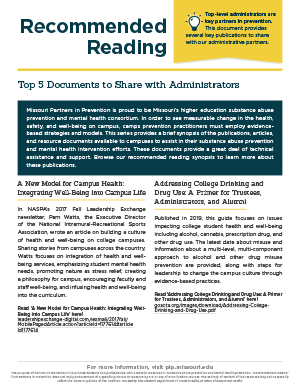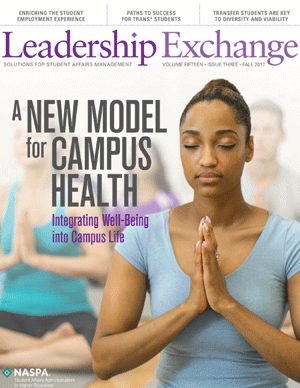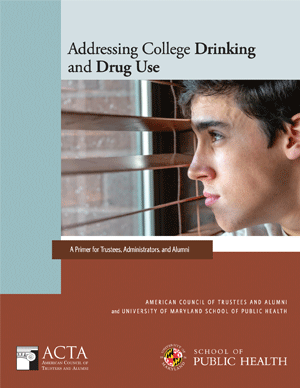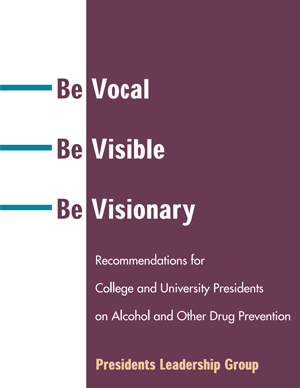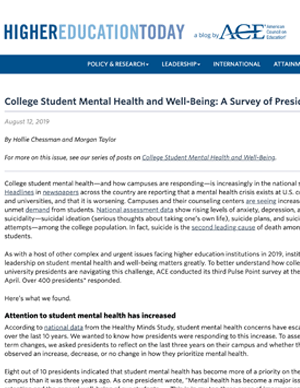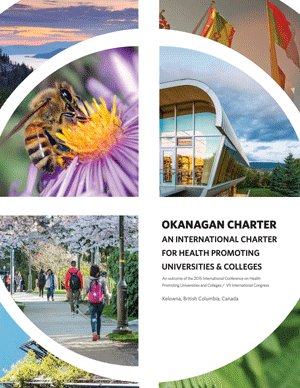
Recommended Reading
Missouri Partners in Prevention is proud to be Missouri’s higher education substance abuse prevention and mental health consortium. In order to see measurable change in the health, safety, and well-being on campus, campus prevention practitioners must employ evidence-based strategies and models. This series provides a brief synopsis of the publications, articles, and resource documents available to campuses to assist in their substance abuse prevention and mental health intervention efforts. These documents provide a great deal of technical assistance and support. Browse our recommended reading synopsis to learn more about these publications.
Click here for the Partners in Prevention Book List!Our Epidemic of Loneliness and Isolation
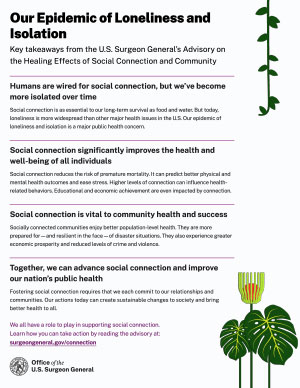 Humans are wired for social connection, but we’re becoming more isolated over time. Loneliness and social isolation represent significant threats to individual and societal health and well-being. Social connection can lead to healthier, more prosperous and resilient individuals and communities. Learn more about how we can work together to advance social connection and improve our nation’s public health. For the original publication, click here.
Humans are wired for social connection, but we’re becoming more isolated over time. Loneliness and social isolation represent significant threats to individual and societal health and well-being. Social connection can lead to healthier, more prosperous and resilient individuals and communities. Learn more about how we can work together to advance social connection and improve our nation’s public health. For the original publication, click here.
Prevention with Purpose: A Strategic Planning Guide for Preventing Drug Misuse Among College Students
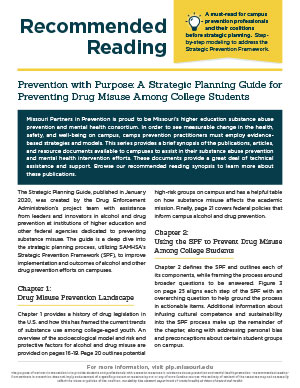
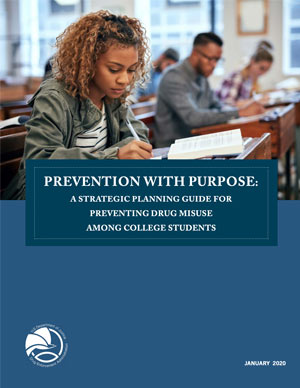 The Strategic Planning Guide, published in January 2020, was created by the Drug Enforcement Administration’s project team with assistance from leaders and innovators in alcohol and drug prevention at institutions of higher education and other federal agencies dedicated to preventing substance misuse. The guide is a deep dive into the strategic planning process, utilizing SAMHSA’s Strategic Prevention Framework (SPF), to improve implementation and outcomes of alcohol and other drug prevention efforts on campuses. For the original publication, click here.
The Strategic Planning Guide, published in January 2020, was created by the Drug Enforcement Administration’s project team with assistance from leaders and innovators in alcohol and drug prevention at institutions of higher education and other federal agencies dedicated to preventing substance misuse. The guide is a deep dive into the strategic planning process, utilizing SAMHSA’s Strategic Prevention Framework (SPF), to improve implementation and outcomes of alcohol and other drug prevention efforts on campuses. For the original publication, click here.
A Guide to Campus Mental Health Action Planning
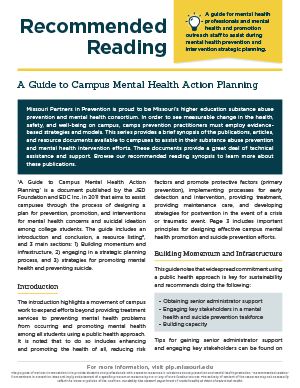
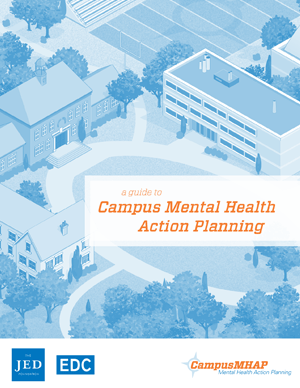 ‘A Guide to Campus Mental Health Action Planning’ is a document published by the JED Foundation and EDC Inc. in 2011 that aims to assist campuses through the process of designing a plan for prevention, promotion, and interventions for mental health concerns and suicidal ideation among college students. The guide includes an introduction and conclusion, a resource listing*, and 3 main sections: 1) Building momentum and infrastructure, 2) engaging in a strategic planning process, and 3) strategies for promoting mental health and preventing suicide. For the original publication, click here.
‘A Guide to Campus Mental Health Action Planning’ is a document published by the JED Foundation and EDC Inc. in 2011 that aims to assist campuses through the process of designing a plan for prevention, promotion, and interventions for mental health concerns and suicidal ideation among college students. The guide includes an introduction and conclusion, a resource listing*, and 3 main sections: 1) Building momentum and infrastructure, 2) engaging in a strategic planning process, and 3) strategies for promoting mental health and preventing suicide. For the original publication, click here.
NIAAA’s College AIM
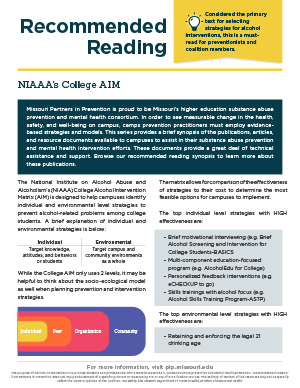
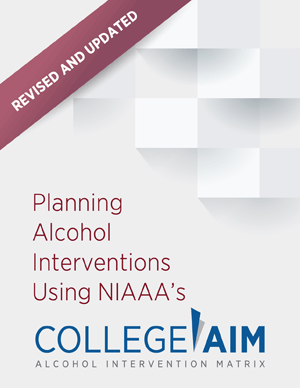 The National Institute on Alcohol Abuse and Alcoholism’s (NIAAA) College Alcohol Intervention Matrix (AIM) is designed to help campuses identify individual and environmental level strategies to prevent alcohol-related problems among college students.
The National Institute on Alcohol Abuse and Alcoholism’s (NIAAA) College Alcohol Intervention Matrix (AIM) is designed to help campuses identify individual and environmental level strategies to prevent alcohol-related problems among college students.
While the College AIM only uses 2 levels, it may be helpful to think about the socio-ecological model as well when planning prevention and intervention strategies. For the original publication, click here.
Addressing Alcohol-Related Harms: A Population Level Response
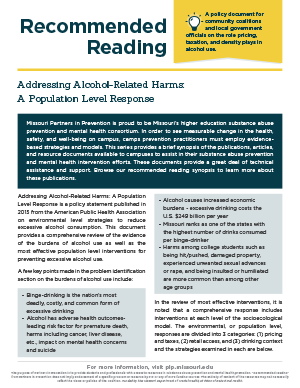
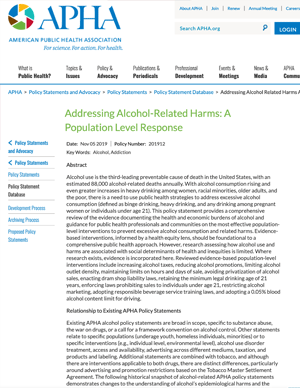 The Addressing Alcohol-Related Harms: A Population Level Response is a policy statement published in 2015 from the American Public Health Association on environmental level strategies to reduce excessive alcohol consumption. This document provides a comprehensive review of the evidence of the burdens of alcohol use as well as the most effective population level interventions for preventing excessive alcohol use. For the original publication, click here.
The Addressing Alcohol-Related Harms: A Population Level Response is a policy statement published in 2015 from the American Public Health Association on environmental level strategies to reduce excessive alcohol consumption. This document provides a comprehensive review of the evidence of the burdens of alcohol use as well as the most effective population level interventions for preventing excessive alcohol use. For the original publication, click here.
Focus on Prevention: Strategies and Programs to Prevent Substance Use
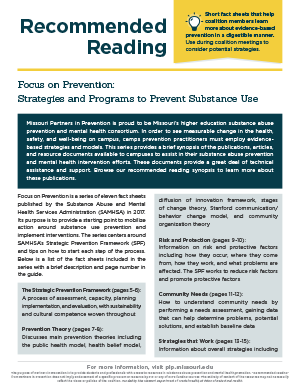
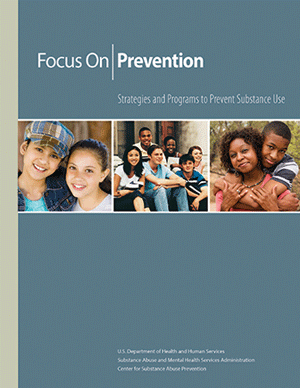 Focus on Prevention is a series of eleven fact sheets published by the Substance Abuse and Mental Health Services Administration (SAMHSA) in 2017. Its purpose is to provide a starting point to mobilize action around substance use prevention and implement interventions. The series centers around SAMHSA’s Strategic Prevention Framework (SPF) and tips on how to start each step of the process. Below is a list of the fact sheets included in the series with a brief description and page number in the guide. For the original publication, click here.
Focus on Prevention is a series of eleven fact sheets published by the Substance Abuse and Mental Health Services Administration (SAMHSA) in 2017. Its purpose is to provide a starting point to mobilize action around substance use prevention and implement interventions. The series centers around SAMHSA’s Strategic Prevention Framework (SPF) and tips on how to start each step of the process. Below is a list of the fact sheets included in the series with a brief description and page number in the guide. For the original publication, click here.
Framing Well-Being in a College Campus Setting
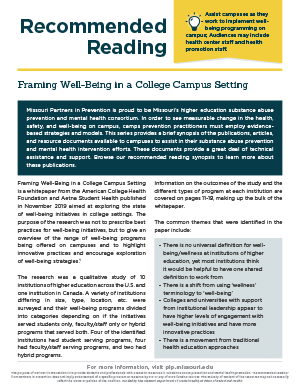
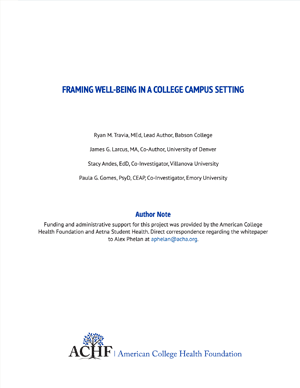 Framing Well-Being in a College Campus Setting is a whitepaper from the American College Health Foundation and Aetna Student Health published in November 2019 aimed at exploring the state of well-being initiatives in college settings. The purpose of the research was not to prescribe best practices for well-being initiatives, but to give an overview of the range of well-being programs being offered on campuses and to highlight innovative practices and encourage exploration of well-being strategies. For the original publication, click here.
Framing Well-Being in a College Campus Setting is a whitepaper from the American College Health Foundation and Aetna Student Health published in November 2019 aimed at exploring the state of well-being initiatives in college settings. The purpose of the research was not to prescribe best practices for well-being initiatives, but to give an overview of the range of well-being programs being offered on campuses and to highlight innovative practices and encourage exploration of well-being strategies. For the original publication, click here.
Michigan Collegiate Cannabis Prevention Toolkit
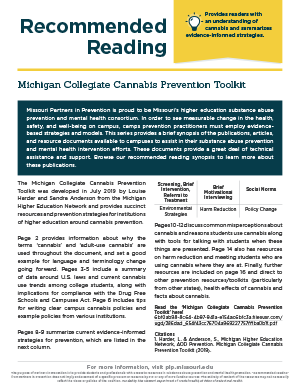
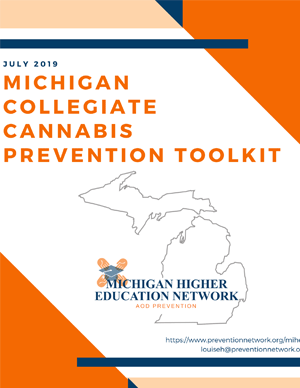 The Michigan Collegiate Cannabis Prevention Toolkit was developed in July 2019 by Louise Harder and Sandra Anderson from the Michigan Higher Education Network and provides succinct resources and prevention strategies for institutions of higher education around cannabis prevention.
The Michigan Collegiate Cannabis Prevention Toolkit was developed in July 2019 by Louise Harder and Sandra Anderson from the Michigan Higher Education Network and provides succinct resources and prevention strategies for institutions of higher education around cannabis prevention.
Page 2 provides information about why the terms ‘cannabis’ and ‘adult-use cannabis’ are used throughout the document, and set a good example for language and terminology change going forward. For the original publication, click here.
The Okanagan Charter
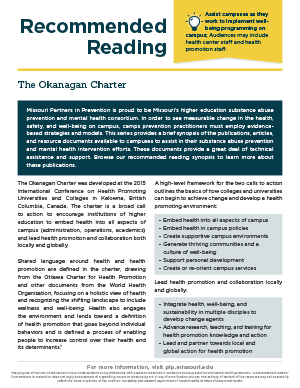
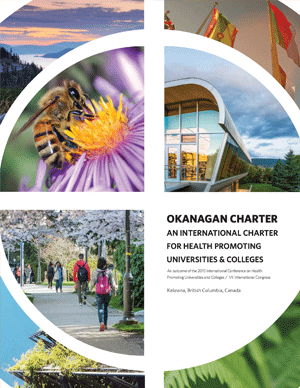 The Okanagan Charter was developed at the 2015 International Conference on Health Promoting Universities and Colleges in Kelowna, British Columbia, Canada. The charter is a broad call to action to encourage institutions of higher education to embed health into all aspects of campus (administration, operations, academics) and lead health promotion and collaboration both locally and globally. For the original publication, click here.
The Okanagan Charter was developed at the 2015 International Conference on Health Promoting Universities and Colleges in Kelowna, British Columbia, Canada. The charter is a broad call to action to encourage institutions of higher education to embed health into all aspects of campus (administration, operations, academics) and lead health promotion and collaboration both locally and globally. For the original publication, click here.
Predictors of Alcohol Use during the First Year of College: Implications for Prevention
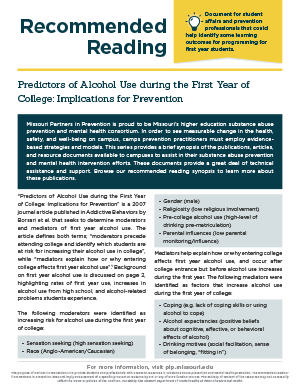
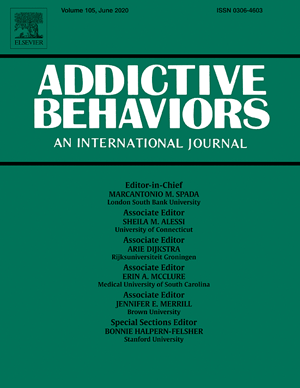 “Predictors of Alcohol Use during the First Year of College: Implications for Prevention” is a 2007 journal article published in Addictive Behaviors by Borsari et al. that seeks to determine moderators and mediators of first year alcohol use. The article defines both terms; “moderators precede attending college and identify which students are at risk for increasing their alcohol use in college”, while “mediators explain how or why entering college affects first year alcohol use”.1 Background on first year alcohol use is discussed on page 2, highlighting rates of first year use, increases in alcohol use from high school, and alcohol-related problems students experience. For the original publication, click here.
“Predictors of Alcohol Use during the First Year of College: Implications for Prevention” is a 2007 journal article published in Addictive Behaviors by Borsari et al. that seeks to determine moderators and mediators of first year alcohol use. The article defines both terms; “moderators precede attending college and identify which students are at risk for increasing their alcohol use in college”, while “mediators explain how or why entering college affects first year alcohol use”.1 Background on first year alcohol use is discussed on page 2, highlighting rates of first year use, increases in alcohol use from high school, and alcohol-related problems students experience. For the original publication, click here.
Preventing Substance Misuse Among 18 to 25-Year-Olds: Programs and Strategies
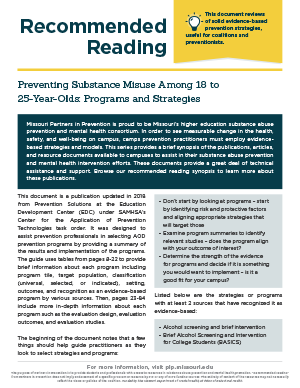
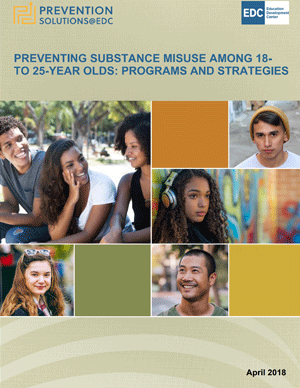 This document is a publication updated in 2018 from Prevention Solutions at the Education Development Center (EDC) under SAMHSA’s Center for the Application of Prevention Technologies task order. It was designed to assist prevention professionals in selecting AOD prevention programs by providing a summary of the results and implementation of the programs. The guide uses tables from pages 8-22 to provide brief information about each program including program tile, target population, classification (universal, selected, or indicated), setting, outcomes, and recognition as an evidence-based program by various sources. Then, pages 23-84 include more in-depth information about each program such as the evaluation design, evaluation outcomes, and evaluation studies. For the original publication, click here.
This document is a publication updated in 2018 from Prevention Solutions at the Education Development Center (EDC) under SAMHSA’s Center for the Application of Prevention Technologies task order. It was designed to assist prevention professionals in selecting AOD prevention programs by providing a summary of the results and implementation of the programs. The guide uses tables from pages 8-22 to provide brief information about each program including program tile, target population, classification (universal, selected, or indicated), setting, outcomes, and recognition as an evidence-based program by various sources. Then, pages 23-84 include more in-depth information about each program such as the evaluation design, evaluation outcomes, and evaluation studies. For the original publication, click here.
Standards of Practice for Health Promotion in Higher Education
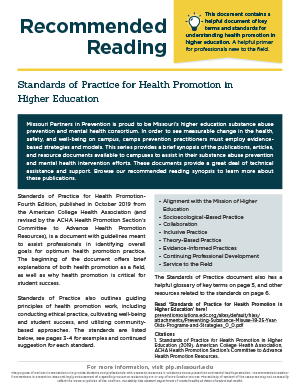
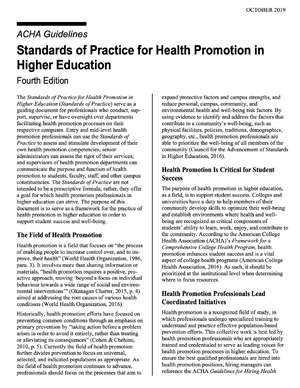 Standards of Practice for Health Promotion- Fourth Edition, published in October 2019 from the American College Health Association (and revised by the ACHA Health Promotion Section’s Committee to Advance Health Promotion Resources), is a document with guidelines meant to assist professionals in identifying overall goals for optimum health promotion practice. The beginning of the document offers brief explanations of both health promotion as a field, as well as why health promotion is critical for student success. For the original publication, click here.
Standards of Practice for Health Promotion- Fourth Edition, published in October 2019 from the American College Health Association (and revised by the ACHA Health Promotion Section’s Committee to Advance Health Promotion Resources), is a document with guidelines meant to assist professionals in identifying overall goals for optimum health promotion practice. The beginning of the document offers brief explanations of both health promotion as a field, as well as why health promotion is critical for student success. For the original publication, click here.
The Academic Opportunity Costs of Substance Use During College
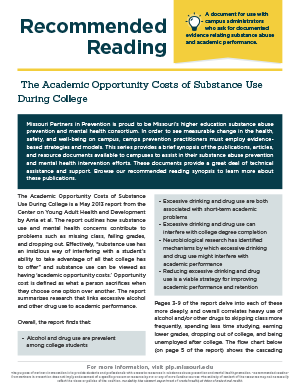
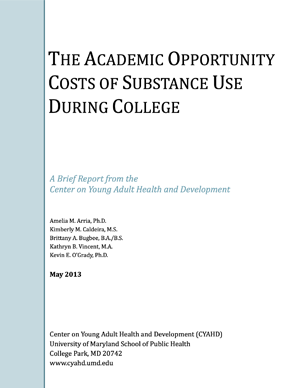 The Academic Opportunity Costs of Substance Use During College is a May 2013 report from the Center on Young Adult Health and Development by Arria et al. The report outlines how substance use and mental health concerns contribute to problems such as missing class, failing grades, and dropping out. Effectively, “substance use has an insidious way of interfering with a student’s ability to take advantage of all that college has to offer”1 and substance use can be viewed as having ‘academic opportunity costs.’ Opportunity cost is defined as what a person sacrifices when they choose one option over another. The report summarizes research that links excessive alcohol and other drug use to academic performance. For the original publication, click here.
The Academic Opportunity Costs of Substance Use During College is a May 2013 report from the Center on Young Adult Health and Development by Arria et al. The report outlines how substance use and mental health concerns contribute to problems such as missing class, failing grades, and dropping out. Effectively, “substance use has an insidious way of interfering with a student’s ability to take advantage of all that college has to offer”1 and substance use can be viewed as having ‘academic opportunity costs.’ Opportunity cost is defined as what a person sacrifices when they choose one option over another. The report summarizes research that links excessive alcohol and other drug use to academic performance. For the original publication, click here.
The Higher Education Cannabis Prevention Toolkit
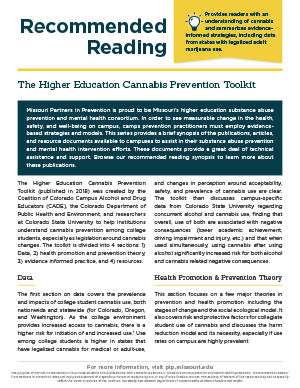
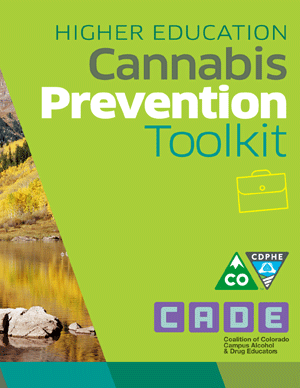 The Higher Education Cannabis Prevention Toolkit (published in 2018) was created by the Coalition of Colorado Campus Alcohol and Drug Educators (CADE), the Colorado Department of Public Health and Environment, and researchers at Colorado State University to help institutions understand cannabis prevention among college students, especially as legislation around cannabis changes. The toolkit is divided into 4 sections: 1) Data, 2) health promotion and prevention theory, 3) evidence informed practice, and 4) resources. For the original publication, click here.
The Higher Education Cannabis Prevention Toolkit (published in 2018) was created by the Coalition of Colorado Campus Alcohol and Drug Educators (CADE), the Colorado Department of Public Health and Environment, and researchers at Colorado State University to help institutions understand cannabis prevention among college students, especially as legislation around cannabis changes. The toolkit is divided into 4 sections: 1) Data, 2) health promotion and prevention theory, 3) evidence informed practice, and 4) resources. For the original publication, click here.
Preventing Youth Marijuana Use: Programs and Strategies
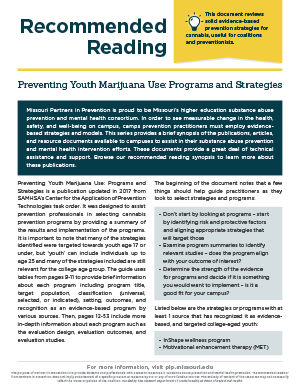
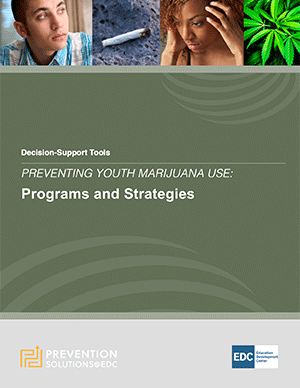 Preventing Youth Marijuana Use: Programs and Strategies is a publication updated in 2017 from SAMHSA’s Center for the Application of Prevention Technologies task order. It was designed to assist prevention professionals in selecting cannabis prevention programs by providing a summary of the results and implementation of the programs. It is important to note that many of the strategies identified were targeted towards youth age 17 or under, but ‘youth’ can include individuals up to age 25 and many of the strategies included are still relevant for the college age group. The guide uses tables from pages 9-11 to provide brief information about each program including program title, target population, classification (universal, selected, or indicated), setting, outcomes, and recognition as an evidence-based program by various sources. Then, pages 12-53 include more in-depth information about each program such as the evaluation design, evaluation outcomes, and evaluation studies. For the original publication, click here.
Preventing Youth Marijuana Use: Programs and Strategies is a publication updated in 2017 from SAMHSA’s Center for the Application of Prevention Technologies task order. It was designed to assist prevention professionals in selecting cannabis prevention programs by providing a summary of the results and implementation of the programs. It is important to note that many of the strategies identified were targeted towards youth age 17 or under, but ‘youth’ can include individuals up to age 25 and many of the strategies included are still relevant for the college age group. The guide uses tables from pages 9-11 to provide brief information about each program including program title, target population, classification (universal, selected, or indicated), setting, outcomes, and recognition as an evidence-based program by various sources. Then, pages 12-53 include more in-depth information about each program such as the evaluation design, evaluation outcomes, and evaluation studies. For the original publication, click here.
Top 5 Documents to Share with Administrators
Click on an image below to learn more!
- Read ‘A New Model for Campus Health: Integrating Well- Being into Campus Life’ here!
- Read ‘Addressing College Drinking and Drug Use: A Primer for Trustees, Administrators, and Alumni’ here!
- Read ‘Be Vocal, Be Visible, Be Visionary: Recommendations for College and University Presidents on Alcohol and Other Drug Prevention’ here!
- Read ‘College Student Mental Health and Well-Being: A Survey of Presidents’ here!
- Read ‘The Okanagan Charter’ here!
College Alcohol Risk Assessment Guide: Environmental Approaches to Prevention
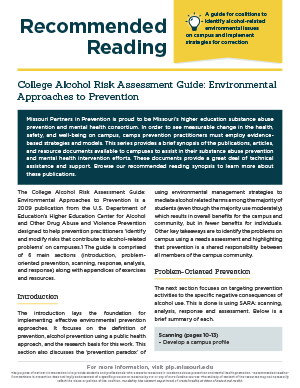
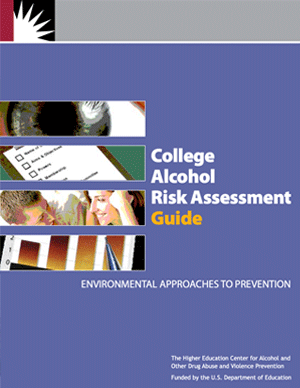 The College Alcohol Risk Assessment Guide: Environmental Approaches to Prevention is a 2009 publication from the U.S. Department of Education’s Higher Education Center for Alcohol and Other Drug Abuse and Violence Prevention designed to help prevention practitioners ‘identify and modify risks that contribute to alcohol-related problems’ on campuses.1 The guide is comprised of 6 main sections (introduction, problem- oriented prevention, scanning, response, analysis, and response) along with appendices of exercises and resources. For the original publication, click here.
The College Alcohol Risk Assessment Guide: Environmental Approaches to Prevention is a 2009 publication from the U.S. Department of Education’s Higher Education Center for Alcohol and Other Drug Abuse and Violence Prevention designed to help prevention practitioners ‘identify and modify risks that contribute to alcohol-related problems’ on campuses.1 The guide is comprised of 6 main sections (introduction, problem- oriented prevention, scanning, response, analysis, and response) along with appendices of exercises and resources. For the original publication, click here.
The Opioid Crisis and the Black/African American Population: An Urgent Issue
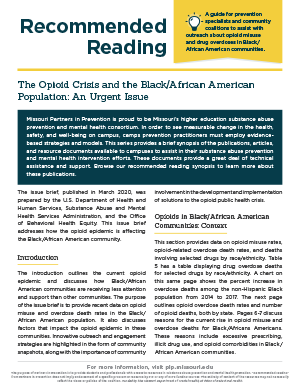
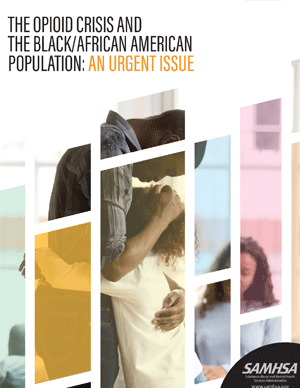 The issue brief, published in March 2020, was prepared by the U.S. Department of Health and Human Services, Substance Abuse and Mental Health Services Administration, and the Office of Behavioral Health Equity. This issue brief addresses how the opioid epidemic is affecting the Black/African American community.
For the original publication, click here.
The issue brief, published in March 2020, was prepared by the U.S. Department of Health and Human Services, Substance Abuse and Mental Health Services Administration, and the Office of Behavioral Health Equity. This issue brief addresses how the opioid epidemic is affecting the Black/African American community.
For the original publication, click here.
The Resurgence of the Drug-Free Schools and Communities Act: A Call to Action
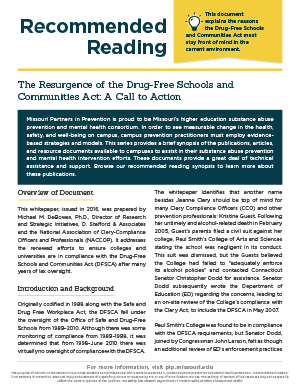
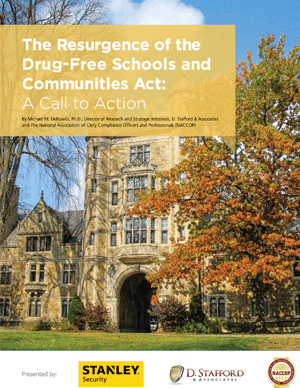 This whitepaper, issued in 2016, was prepared by Michael M. DeBowes, Ph.D., Director of Research and Strategic Initiatives, D. Stafford & Associates and the National Association of Clery-Compliance Officers and Professionals (NACCOP). It addresses the renewed efforts to ensure colleges and universities are in compliance with the Drug-Free Schools and Communities Act (DFSCA) after many years of lax oversight.
For the original publication, click here.
This whitepaper, issued in 2016, was prepared by Michael M. DeBowes, Ph.D., Director of Research and Strategic Initiatives, D. Stafford & Associates and the National Association of Clery-Compliance Officers and Professionals (NACCOP). It addresses the renewed efforts to ensure colleges and universities are in compliance with the Drug-Free Schools and Communities Act (DFSCA) after many years of lax oversight.
For the original publication, click here.
